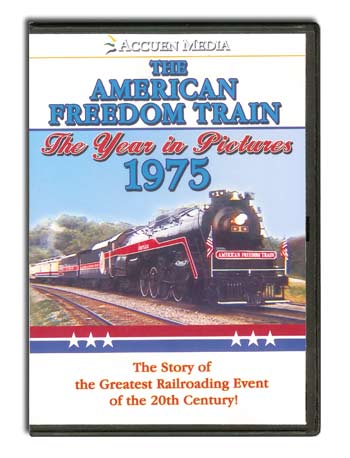
 |
FEATURED
DVD TITLE The Year in Pictures 1975 covers the genesis of the train and its first nine months of life: the design of the train, the restorations of locomotives 4449 and 2101, preparation of the exhibits, and life on the road from April 1 in Wilmington, DE to yearís end in Southern California. The story of this incredible journey is illustrated by hundreds of never-before-seen photographs by the trainís staff, designers, builders and the railfans who chased it! Companion
volume to |
||
|
Video Description The American Freedom Train was the greatest railroading event of the 20th century. For 21 months in 1975 and 1976 this 25-car steam-powered train crisscrossed the nation in celebration of the Bicentennial of the America Revolution. Over seven million people would seek out the train on its 25,833 mile journey - venturing aboard to witness over 500 precious artifacts significant in the shaping of their country. Forty million more would watch the train go by at trackside. The American Freedom Train: The Year In Pictures 1975 covers the first year of the AFT's life - illustrated through hundreds of never-before-seen photographs from noted railroad photographers, AFT staff and locomotive crews. From opening day in Wilmington, Delaware to New Year's eve in Pomona, California, this is the incredible story of the genesis, construction, and first transcontinental trip of America's greatest Bicentennial celebration. The brainchild of Ross Rowland Jr., a successful New York commodities broker and steam engineer, the American Freedom Train became a reality when Pepsi Cola, Kraft Foods, General Motors, Prudential Insurance and ARCO each donated one million dollars to give America a birthday present like no other. Though privately funded, the AFT was to be non-commercial. In return for their sponsorship, four of these five companies merely accepted recognition on a small bronze plaque inside the train. ARCO opted out of taking even that much recognition. Pulling such a magnificent train would require the finest motive power ever put on rails. To Ross Rowland, that meant only one thing: steam. This volume begins by chronicling the return to life of two huge steam locomotives: The former Southern Pacific GS-4 'Daylight' #4449, and the Reading T-1 #2101. Both giants were pulled from their slumber - one from a public park in Portland, Oregon, the other from a supply company in Baltimore. The immense Daylight was chosen for the Western portion of the AFT's journey, while the slightly shorter Reading engine would negotiate the tighter clearances of the Eastern US. Over a year earlier, with President Richard Nixon's blessing, the National Archives had opened its vaults to the AFT's designers and the stage had been set for the most incredible traveling exhibit of American history ever made. Railroad artist Bob Lorenz had given form to Rowland's dream through pre-production paintings and art. With $5,000,000 dollars to spend, noted museum and exhibit designer Barry Howard and his staff fleshed out the train, and for the first time gave life to the concept we take for granted in design today: Multi-media. A moving walkway would carry visitors through 10 display cars converted from former New York Central/Penn Central baggage cars. For twenty minutes visitors would be awash in the American experience. In front of them would pass George Washington's copy of the Constitution, Hank Aaron's "714" bat, Martin Luther King's Vestments and Bible, the original Louisiana Purchase, paintings by Thomas Hart Benton and Georgia O'keeffe, Jack Benny's violin, Judy Garland's dress from the Wizard of Oz, John F. Kennedy's rocking chair, Abraham Lincoln's stovepipe hat, and even a rock form the moon. All enhanced by photographic and video images, narration and music. (A tour through the inside of the AFT is given in the second DVD in this series: "The American Freedom Train: The Year in Pictures 1976", available separately.) The first year took the AFT (roughly) up the East coast, across the upper Mid-west and down the Western coast of the United States. Because the $2 admission fee was deemed too high by city officials (after all, anyone could simply go to Washington D.C. and see half of these artifacts for free), the AFT never displayed in Los Angeles, but instead ended 1975 at the LA County Fairgrounds in Pomona, CA. There the massive Daylight engine was dressed as Santa Claus and the Bicentennial year dawned. This video focuses on the design work of the train (through artist's renderings of proposed exhibits and paint schemes) as well as selection and restoration of the two steam locomotives, especially the Daylight (which was restored in six months, compared to 30 days for the Reading T-1). The tape chronicles the AFT's first nine months on the road featuring stops in Wilmington (Delaware), Archbold (Ohio), Chicago, Omaha (where Daylight 4449 was double-headed with the Union Pacific's own steam engine, 8444), Colorado Springs (pulled briefly by diesels), Boise, Seattle (where Royal Hudson #2860 displayed with the AFT), Portland, Sacramento, San Francisco, and Pomona, among others. The production ends with a look at the physical parts of the train: the first two locomotives, the flatcars, the showcase cars, the display cars, and the passenger cars. |
|||
